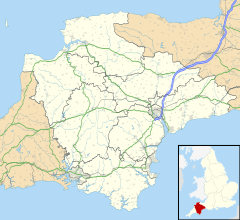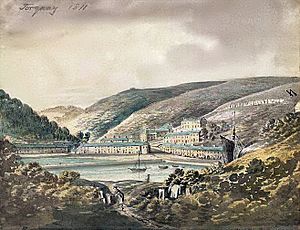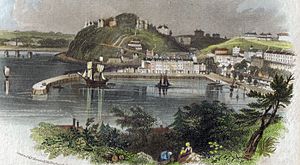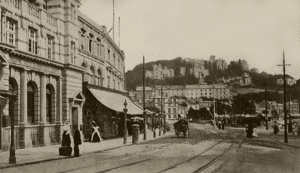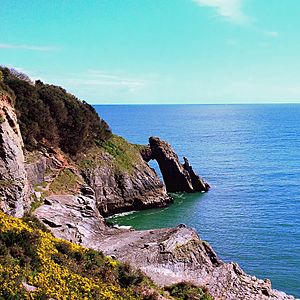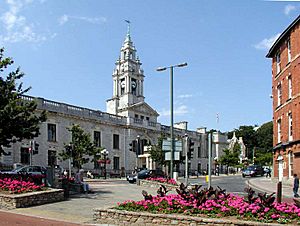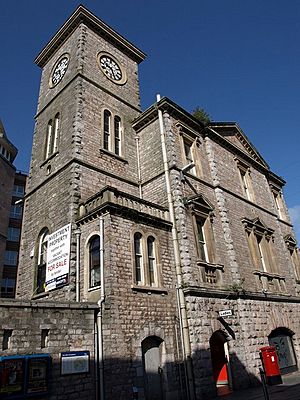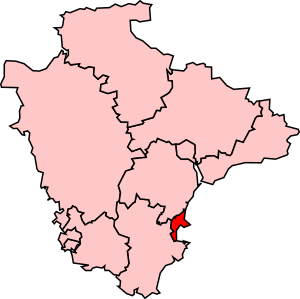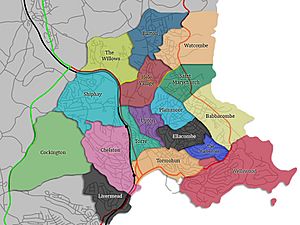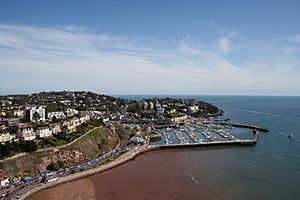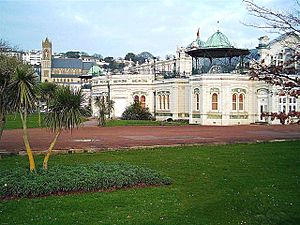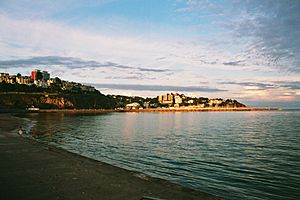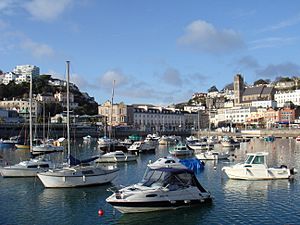Torquay facts for kids
Quick facts for kids Torquay |
|
|---|---|
| Town | |
 View across Torquay Harbour |
|
| Population | 65,245 (2011) |
| OS grid reference | SX915655 |
| Unitary authority | |
| Ceremonial county | |
| Region | |
| Country | England |
| Sovereign state | United Kingdom |
| Post town | TORQUAY |
| Postcode district | TQ1, TQ2 |
| Dialling code | 01803 |
| Police | Devon and Cornwall |
| Fire | Devon and Somerset |
| Ambulance | South Western |
| EU Parliament | South West England |
| UK Parliament |
|
Torquay (pronounced tor-KEE) is a lovely seaside town in Devon, England. It's part of the Torbay area, which is like a special local government region. You can find it about 18 miles (29 km) south of Exeter and 28 miles (45 km) east of Plymouth. Torquay sits on the north side of Tor Bay, right next to Paignton and across from the fishing port of Brixham.
Long ago, Torquay was known for fishing and farming. But in the early 1800s, it started to become a popular place for holidays by the sea. People from the Victorian times loved it! Because of its mild weather, Torquay even got the nickname "the English Riviera".
The famous writer Agatha Christie was born here and lived in Torquay when she was young. There's even an "Agatha Christie Mile" where you can follow a tour with special plaques about her life and books. The poet Elizabeth Barrett Browning also lived in Torquay for a few years, hoping the mild climate would help her health.
Contents
What's in a Name?
Torquay's name comes from being the "quay" (a place where boats dock) for an old village called Torre. The name Torre itself comes from a type of rocky hill called a tor. You can still see parts of these old quarries near Lymington Road. So, the name slowly changed from Torrequay to Torquay!
A Look Back in Time
The area where Torquay is today has been lived in for a very long time, even since the Paleolithic (Stone Age) period. Tools found in Kents Cavern are 40,000 years old! Some bone fragments found there might even be from the oldest modern humans in Europe, dating back 37,000 to 40,000 years ago.
Even Roman soldiers visited Torquay. They left offerings at a unique rock formation in Kents Cavern called "The Face."
The first big building in Torquay was Torre Abbey, a monastery built in 1196. Torquay stayed a small place until the Napoleonic Wars (early 1800s). During these wars, Torbay was a safe place for the British navy to anchor. Families of officers started visiting Torquay. People also found that the mild weather here was great for recovering from illnesses. Because of this, Torquay grew very quickly. Its population went from 838 people in 1801 to 24,767 in 1887!
Torquay grew even more when the Torre railway station opened in 1848. Better train links meant more visitors and faster growth. The main Torquay railway station opened in 1859, offering amazing sea views from its platforms. By 1892, Torquay had grown so much that it became a municipal borough, which meant it had its own local government.
Electric street trams ran in Torquay from 1907. At first, they used a special system to avoid overhead wires, but later they switched to normal overhead lines. The tram line even went to Paignton in 1911, but the whole system closed in 1934.
The Royal National Lifeboat Institution had a lifeboat station in Torquay from 1876 to 1923. Torquay was also seen as a "Spa Town" after the Marine Spa was built in 1853. It had an outdoor swimming pool filled by the tide! Famous writer Charles Dickens even gave readings there.
During World War I, Torquay had military hospitals, and many soldiers recovering from the Battle of Gallipoli stayed here. King George V and Queen Mary visited in 1915.
In World War II, many children and families from London came to Torquay because it was considered safer. The town did get some small bomb damage, mostly from planes dropping extra bombs after attacking Plymouth. Before the D-Day landings in June 1944, thousands of US Army soldiers arrived in Torquay. Over 23,000 American soldiers left Torquay for Utah Beach on D-Day. You can still see the loading ramps they used in front of the Regina Hotel.
Torquay hosted the water sport events for the 1948 Summer Olympics. The Olympic flame was even brought from London to Torre Abbey Gardens! While Torquay didn't host events for the 2012 Summer Olympics, the flame passed through again, and the town hoped to host teams for training.
After World War II, many tall apartment buildings were built above the cliffs and harbour, making the area feel a bit like Monte Carlo. In 1971, the Marine Spa was taken down to build a new leisure complex called Coral Island. This complex opened in 1977 but closed in 1988 and was demolished in 1997. The site was empty until 2002 when the Living Coasts coastal zoo was built there.
In the late 1980s, the Fleet Street area was rebuilt into the Fleet Walk shopping centre. More recently, the Rock Walk on the seafront was updated and reopened in 2010.
How Torquay is Governed
Torquay is governed by a single local council called Torbay Council. This council covers a larger area than just Torquay, including Paignton and Brixham. Torbay Council's main office is at Torquay Town Hall.
Historically, Torquay was part of the old area called Tormoham. In 1835, special "improvement commissioners" were appointed to help manage the town. These were replaced in 1850 by an elected local board. One of their first projects was to build a town hall on Union Street, which was finished in 1852.
In 1876, the local board changed its name to the Torquay Local Board, as Torquay was the more common name for the town. In 1892, Torquay officially became a municipal borough, run by a town council. The borough grew in 1900 to include St Marychurch and parts of Chelston. In 1911, a new town hall was built.
In 1968, Torquay, Paignton, and Brixham joined together to form a larger area called Torbay. This new area was independent from Devon County Council. Then, in 1974, local government changed again, and Torbay became part of Devon County Council once more. However, in 1998, Torbay became a unitary authority again, meaning it runs its own local services.
Torquay is also part of the Torbay parliamentary constituency. This area elects one Member of Parliament (MP) to represent it in the UK Parliament. Since 2024, the MP for Torbay has been Steve Darling from the Liberal Democrats.
Torquay's Location and Landscape
Torquay is on the southwestern coast of England and makes up one-third of the beautiful Torbay area. It has a special mild climate, getting some of the most sunshine in the southwest UK. Winters here are usually mild and wet.
The town is actually made up of several smaller settlements that grew together over time. The older parts include Tormohun, Wellswood, The Warberries, Upton, and Ellacombe. Later, areas like Chelston, Livermead, and St Marychurch (which includes Plainmoor, Watcombe, Babbacombe, and Kingskerswell) became part of Torquay.
Wellswood and the Lincombes areas were built by rich Victorians who loved the Mediterranean style. They built large villas with Italian-style features and towers. You'll see many pine trees, Bay bushes, palm trees, and "cabbage trees" (also called "Torbay Palms") here. These cabbage trees were brought from New Zealand in 1820 and have grown very well in the area.
Torquay has many lovely beaches, including Oddicombe Beach, Meadfoot Beach, Maidencombe, Watcombe, Babbacombe Beach, Anstey's Cove, Redgate, Torre Abbey Sands, Corbyn Sands, Institute Beach, and Hollacombe Beach. Oddicombe and Meadfoot beaches even had the "European Blue Flag" status in 2012, meaning they are very clean and safe.
On the coast near Wellswood, you can see London Bridge, which is a natural rock arch. It's a great sight from the South West Coast Path.
Getting Around Torquay
Trains
Torquay has two train stations. Torquay railway station is close to the sea and Torre Abbey Sands. Torre railway station is a bit further inland. Not all trains stop at Torre. There have been plans to improve these stations and build a new one at Edginswell.
Roads
Torquay is connected to the UK's main road network by the A380. This road goes around the edge of the town and links to the A38 and the M5 at Exeter. The A3022 road leads into Torquay and then continues to Paignton. The A379 goes past the harbour to Babbacombe and St Marychurch, and then north along the coast to Teignmouth. A new dual carriageway (a road with two lanes in each direction) was finished in 2015, making travel easier.
Buses
The main bus company in Torquay is Stagecoach South West. Bus service 12 goes through Torquay, connecting Newton Abbot and Brixham. Many other bus routes operate within the town itself.
Religion in Torquay
Torquay has about 60 churches from different Christian groups. Central Church, which is both Methodist and United Reformed Church, has a very interesting front wall. There are also two Roman Catholic churches, both built in the 1800s and considered important historic buildings.
Besides Christian churches, Torquay also has an Islamic centre and mosque.
Economy and Tourism
Torquay is a popular tourist destination with many attractions. One of the most important is Kents Cavern, Britain's most significant Stone Age site. Early humans lived here for about 40,000 years! Explorers like Rev. J. McEnery and William Pengelly found evidence that humans and extinct animals lived together here. Many famous people have visited the caves, including Agatha Christie, Beatrix Potter, King George V, and Haile Selassie.
On the seafront, near the Rock Walk and the Marina, you'll find the Victorian Pavilion. Next to it is the "Friends Fountain" and the English Riviera Wheel, a 100-foot-high Ferris wheel that gives amazing views of Torquay Harbour.
Torquay Museum, founded in 1844, is the oldest museum in Devon. It has large collections of geology, natural science, archaeology, and items from different cultures. You can learn about the history of the English Riviera Geopark, see fossils, and explore artifacts from Kents Cavern. The museum also has sections about Agatha Christie, ancient Egypt, explorers, and ecology.
The Living Coasts coastal zoo was built on the site of the old Bath's Saloons complex. It was designed to house marine birds and other coastal animals. Sadly, Living Coasts closed permanently in June 2020 due to the COVID-19 pandemic.
Other fun places to visit include the Babbacombe Model Village, which opened in 1963, and the Babbacombe Theatre, which opened in 1939. The Princess Theatre is also a popular venue.
Torquay was also home to Suttons Seeds, a well-known seed company, until 1998.
Culture and Entertainment
Arts and Performance
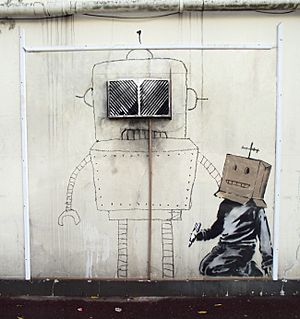
In the early days of British movies, two film companies operated in Torquay. More recently, Devon Films, based in Torquay, has become the area's newest film production company.
The Princess Theatre, located by the harbour, is Torquay's largest theatre with about 1,500 seats. It hosts many touring shows and events. The TOADS Theatre Company runs the Little Theatre in Meadfoot, putting on their own plays and hosting other groups. The Babbacombe Theatre is famous for having the longest-running summer show in the country.
Creative Torbay is a website supported by Torbay Council that helps local artists and cultural groups promote their work.
Media
Torquay has several local radio stations, including BBC Radio Devon, Heart West, and Greatest Hits Radio South West. Local TV news is provided by BBC South West and ITV West Country.
The town's local newspaper is the Herald Express, which has been published since 1925.
Sports
Torquay has a long history of hosting sailing events because of its sheltered bay. This tradition was highlighted in 1948 when the water sport events of the 1948 Summer Olympics were held here.
In association football (soccer), Torquay is represented by Torquay United F.C.. The team plays its home games at Plainmoor. They have sometimes reached the third level of English football leagues. In 2009, they won a play-off final at Wembley to get promoted, but they were relegated back to the National League in 2014.
Education in Torquay
Torquay has many primary schools, like St Margaret's Primary School in St Marychurch.
There are five main secondary schools in the town. Torquay Academy (formerly Torquay Community School) has improved a lot and had a £26 million rebuild. It became an academy in 2001.
The Spires College (formerly Westlands School) is a secondary school and sixth form that moved to a new building in 2002. St Cuthbert Mayne School is a joint Roman Catholic and Church of England secondary school and sixth form.
Torquay also has two selective state secondary schools: Torquay Boys' Grammar School and Torquay Grammar School for Girls. Students need to pass the Eleven plus exam to get into these schools. There are also some private schools in the area.
For further education after secondary school, students can go to the sixth forms at The Spires, St Cuthbert's Mayne, or the Grammar schools. They can also attend South Devon College, which has a new campus in Paignton.
Healthcare
Torquay has two hospitals. Torbay Hospital is run by the NHS and is located on Newton Road. The private Mount Stuart Hospital is run by Ramsay Health Care UK and is on St Vincent's Road.
Torquay in Popular Culture
Some parts of the famous TV show Monty Python's Flying Circus were filmed in and around Torquay and Paignton. It was while staying in Torquay in 1971 that John Cleese found the idea for the popular sitcom Fawlty Towers. He stayed at the Gleneagles Hotel and later described the owner as "the most wonderfully rude man I have ever met!"
In the 1970s, episodes of the comedy series The Goodies were also filmed here. In 1979, the drama That Summer! was set and filmed in Torquay. The movie Blackball (2003) was also partly shot here.
In 2010, it was reported that the artist Banksy painted a mural on the wall of the Grosvenor Hotel in Torquay. The mural showed a child drawing a robot, using an extractor fan vent as the robot's head. This mural was later painted over when the hotel was refurbished.
The Victorian house where Agatha Christie was born and grew up, Ashfield, was taken down in 1961. A blue plaque was put up in 2007 to mark the spot.
Notable People from Torquay
| Famous People Born in Torquay | |
|---|---|
| 1821 | Richard Burton, explorer and linguist |
| 1867 | Percy Fawcett, archaeologist and explorer |
| 1890 | Agatha Christie, best-selling crime novelist |
| 1937 | Peter Cook, writer and comedian |
| 1947 | Martin Turner, Wishbone Ash founder |
| 1949 | Roger Deakins, cinematographer |
| 1972 | Miranda Hart, actress and comedian |
| 1983 | Lauren Pope, DJ, model and entrepreneur |
| 1987 | Lily Cole, model and actress |
| 1994 | Georgia Toffolo, TV and media personality |
- Sir Richard Francis Burton – A British explorer, writer, and military officer.
- Agatha Christie – The famous English mystery and detective writer.
- Peter Cook – An English comedian, actor, and writer.
- Roger Deakins – An English cinematographer who works on movies.
- Max Evans – A rugby player.
- Percy Fawcett – An English explorer.
- Larry Grayson – An English comedian and TV presenter who lived in Torquay later in life.
- Penny Mordaunt – An English politician.
- Ollie Watkins – An English footballer for Aston Villa F.C. and the England national football team.
- Mike Westmacott – A mountaineer who was part of the team that successfully climbed Mount Everest in 1953.
|
See also
 In Spanish: Torquay para niños
In Spanish: Torquay para niños


